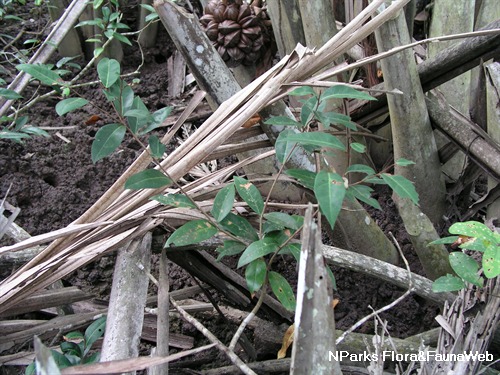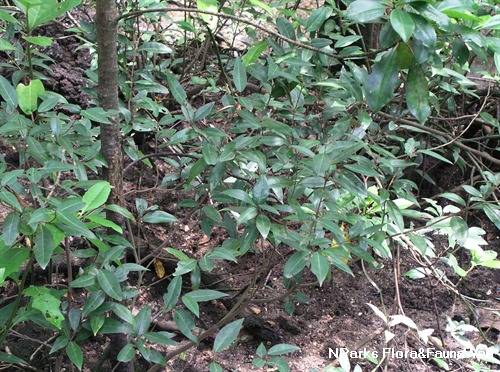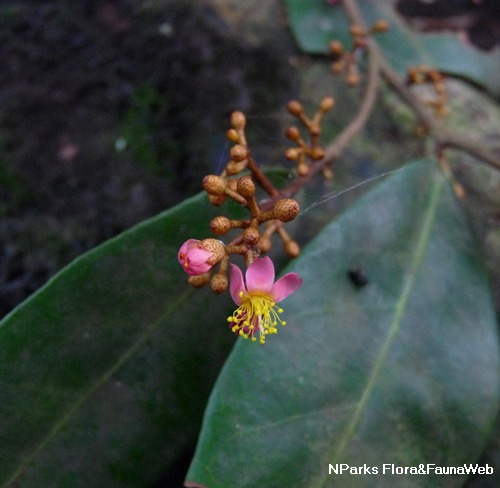
Back
Brownlowia tersa (L.) Kosterm.
| Family Name: | Malvaceae |
| Synonyms: | Brownlowia lanceolata Benth., Brownlowia beccarii |
| Common Name: | Dungun, Dungun Air, Maragomon, Nam nong |
Name
Classifications and Characteristics
| Plant Division | Angiosperms (Flowering Seed Plants) (Dicotyledon) |
|---|---|
| Plant Growth Form | Shrub |
| Lifespan (in Singapore) | Perennial |
| Mode of Nutrition | Autotrophic |
| Plant Shape | Irregular |
| Maximum Height | 1.5 m to 5 m |
Biogeography
| Native Distribution | India, to the Moluccas (including Brunei, Cambodia, Indonesia, Malaysia, Myanmar, Philippines, Thailand and Singapore) |
|---|---|
| Native Habitat | Shoreline (Mangrove Forest, Backshore) |
| Preferred Climate Zone | Tropical, Sub-Tropical / Monsoonal |
| Local Conservation Status | Native to Singapore (Critically Endangered (CR)) |
Description and Ethnobotany
| Growth Form | Shrub, usually growing up to 1.5 - 5 m tall, smaller branches are covered with a dense layer flat scales. |
|---|---|
| Foliage | Its spirally arranged, stalked leaves have leaf blades that are narrowly oval, yellow to golden below, and 6.3-13 by 1.9-3.8 cm. Its upper surface is glossy and smooth, while lower surface is greyish-green and covered with a dense layer of hairy scales. |
| Stems | Grey, smooth with groves along the stem. |
| Flowers | Its 5-petalled flowers grow in flowering shoots that are 5.1-7.6 cm long. |
| Fruit | Its fruit ripens pale, greyish-green in colour, about 1 cm wide and somewhat round to heart-shaped. |
| Habitat | It grows in mangrove forests. It occurs locally in the Sungei Mandai area, Sungei Buloh Wetland Reserve, and Pulau Ubin. |
| Etymology | Brownlowia, commemorating Lady Brownlow, a patroness of biology in the early 19th century; Latin tersa, neat, the reference to which is unknown. |
| Ethnobotanical Uses | Timber & Products: Used for fencing or as fuelwood. |
Landscaping Features
| Landscaping | It is suitable in parks, in wet areas or saline soils for its attractive coloured foliage. |
|---|---|
| Desirable Plant Features | Ornamental Foliage |
| Landscape Uses | Parks & Gardens, Coastal, Beachfront / Shoreline |
Fauna, Pollination and Dispersal
| Pollination Method(s) | Biotic (Fauna) |
|---|---|
| Seed or Spore Dispersal | Abiotic |
Plant Care and Propagation
| Light Preference | Full Sun, Semi-Shade |
|---|---|
| Water Preference | Moderate Water |
| Rootzone Tolerance | Moist Soils, Waterlogged Soils (Drains Site), Well-Drained Soils, Saline Soils / Salt Spray, Fertile Loamy Soils |
| Propagation Method | Seed |
Foliar
| Foliage Retention | Evergreen |
|---|---|
| Mature Foliage Colour(s) | Green, Yellow / Golden |
| Mature Foliage Texture(s) | Smooth |
| Foliar Type | Simple / Unifoliate |
| Foliar Arrangement Along Stem | Alternate, Spiral |
| Foliar Attachment to Stem | Petiolate |
| Foliar Shape(s) | Non-Palm Foliage (Oval, Lanceolate) |
| Foliar Venation | Pinnate / Net |
| Foliar Margin | Entire |
Floral (Angiosperm)
| Flower & Plant Sexuality | Bisexual Flowers |
| Flower Colour(s) | Pink, Yellow / Golden |
|---|---|
| Flower Grouping | Cluster / Inflorescence |
| Flower Location | Axillary |
| Flower Symmetry | Radial |
Fruit, Seed and Spore
| Fruit Classification | Simple Fruit |
|---|---|
| Fruit Type | Indehiscent Dry Fruit , Nut / Nutlet |
Image Repository
Others
| Master ID | 31054 |
|---|---|
| Species ID | 5441 |
| Flora Disclaimer | The information in this website has been compiled from reliable sources, such as reference works on medicinal plants. It is not a substitute for medical advice or treatment and NParks does not purport to provide any medical advice. Readers should always consult his/her physician before using or consuming a plant for medicinal purposes. |




_lowres.jpg)